The date of Jesus Christ’s birth has been a topic of controversy for centuries. Various theories have placed His birth from 6 BC to 1 AD. As to the season of the year, some claim He was born in the spring, while others feel He was born in the fall. Overwhelmingly, most believe He was born in the winter.
Although an abundance of scriptural and historical evidence proves Jesus was not born on December 25, the majority of professing Christians observe this date as His birthday. Few realize, however, that this date is actually linked to pagan traditions that predate Jesus’ birth by thousands of years. Age-old customs of pagan origin entered the Christian churches many centuries ago and are now viewed as an essential part of Christian worship. Most church-goers today have never thought to ask the question: “Where does Christmas come from anyway?”
Still, Jesus’ birth is a foundational cornerstone of true Christianity—and fulfilled a number of significant prophecies that are recorded in the Old Testament. A proper understanding of the true circumstances of His birth will provide deeper insight into the meaning of His life and the ultimate purpose of His first coming.
Jesus Was Born During the Reign of Herod the Great
The Gospel of Matthew records that the birth of Jesus Christ occurred during the reign of Herod the Great. Shortly after Jesus’ birth, Herod heard that the prophesied King of the Jews had been born and feared the Jews would begin to revolt against his rule (Matt. 2:1-3). God warned Joseph in a dream that Herod would attempt to kill the infant Jesus and instructed him to take Mary and Jesus and flee to Egypt (verse 13). Matthew’s account indicates that Herod died not long after they fled to Egypt. After the death of Herod, Joseph brought Jesus and Mary back to Nazareth, a city in the district of Galilee (Matt. 2:19-23).
This scriptural record offers conclusive evidence that the birth of Jesus occurred a short time before the death of Herod. Through the historical writings of the noted historian Josephus, we can determine precisely when Herod reigned and when he died. Josephus reveals the specific year that Herod was crowned king at Rome: “And thus did this man receive the kingdom, having obtained it on the hundred and eighty-fourth Olympiad, when Caius Domitius Calvinus was consul the second time and Caius Asinius Pollio [the first time]” (Josephus, Antiquities of the Jews, 14:14:5).
An Olympiad is four years in length and is reckoned from July to July. The 184th Olympiad extended from July 1, 44 BC, to June 30, 40 BC. Records of this period show that Calvinus and Pollio were consuls in the year 714 AUC (years from the founding of Rome), which was 40 BC (Finegan, Handbook of Biblical Chronology, p. 96). Thus, we know that Herod became king in 40 BC. While the Olympiad was reckoned from July 1 to June 30, the calendar year for consuls was reckoned from January 1 to December 31. Since the 184th Olympiad ended on June 30, 40 BC, and the consuls did not take office until January 1 of that year, we know that Herod was made king sometime during the six-month period from January through June of 40 BC.
Although Herod was crowned at Rome in 40 BC, three years passed before he conquered Jerusalem and began to reign there. Josephus writes: “When the rigour of winter was over, Herod removed his army, and came near to Jerusalem and pitched his camp hard by the city. Now this was the third year since he had been made king at Rome…” (Josephus, Ant., 14:15:14).
While Herod launched his attack in the spring, it was not until the summer of that year that he was able to take the city of Jerusalem. Josephus reveals the specific date of this event: “[It] was summer time…. This destruction befell the city of Jerusalem when Marcus Agrippa and Canninius Gallus were consuls of Rome, on the hundred eighty and fifth Olympiad, on the third month, on the solemnity of the fast…” (Ibid., 14:16:2, 4).
The 185th Olympiad extended from July 1, 40 BC, to June 30, 36 BC. Agrippa and Gallus became consuls in 717 AUC, which corresponds to 37 BC. The fast of the third month that Josephus refers to was the 23rd of Sivan, according to the Hebrew calendar, which was June 22 on the Julian calendar. Herod completed the conquest of the city of Jerusalem in the summer of 37 BC, and began to reign as king in Jerusalem at that time.
Josephus provides additional historical records concerning the reign of Herod that enable us to determine the time of his death: “[Herod] died … having reigned since he had procured Antigonus to be slain, thirty-four years; but since he had been declared king by the Romans, thirty-seven” (Ibid., 17:8:1). Josephus records elsewhere in the same book that Antigonus was killed shortly after Herod had conquered Jerusalem (Ibid., 14:16:4).
In linking Antigonus’s death with Herod’s conquest of Jerusalem in 37 BC, Josephus confirms that Herod did not reign in Jerusalem until three years after his coronation at Rome. Consequently, there are two methods of reckoning the reign of Herod the Great—the Jewish method, which counts thirty-four years from 37 BC, and the Roman method, which counts thirty-seven years from 40 BC. Since the first year of his reign is included in the count, both methods of reckoning arrive at 4 BC as the end of Herod’s reign. This date is conclusively established by the records of history as the year that Herod died.
Josephus’ detailed account also enables us to pinpoint the time of the year of Herod’s death. Josephus records that Herod died after a total eclipse of the moon—but before Passover. The lunar eclipses that occurred during this period of history have been recorded in the book Solar and Lunar Eclipses of the Ancient Near East by M. Kudler and E. Mickler (published by Neukirchen-Bluyn: Verlas Butson & Bercker Kevelaer, 1971). Here is a listing of relevant lunar eclipses:
- 7 BC - No eclipses
- 6 BC - No eclipses
- 5 BC - Total eclipse, March 23, 8:30 PM
- 5 BC - Total eclipse, September 15, 10:30 PM
- 4 BC - Partial eclipse, March 13, 2:20 AM
- 3 BC - No eclipses
- 2 BC - No eclipses
The first lunar eclipse to occur during this period was a total eclipse on March 23 in the year 5 BC. In this year the Passover, Nisan 14, was observed by the Jews on March 22. Because the scriptural reckoning of days is from sunset to sunset, the Passover day extended from sunset March 21 to sunset March 22. Since the total eclipse that occurred at 8:30 PM on the night of March 23 was after Passover, this was not the eclipse that Josephus refers to in conjunction with Herod’s death.
The second total eclipse of the moon during this period took place on September 15, 5 BC, which was a significant day by scriptural reckoning. According to the Hebrew calendar, September 15 was the 14th of Tishri (the seventh month). The moon was totally eclipsed at 10:30 PM that night, which was the beginning of the 15th of Tishri, the first day of the Feast of Tabernacles. For a total lunar eclipse to occur twice in the same year—such as those in 5 BC—is extremely rare. In fact, such an event only occurs once in about 2717 years (Canon of Lunar Eclipses, 1500 B.C.-A. D. by Bao-Lin and Alan D. Faila).
Josephus’ account of this period of Jewish history includes a number of events which point to this eclipse as the one that occurred shortly before the death of Herod. In recounting the final months of Herod’s reign, Josephus gives us an accurate time frame for establishing the date of Jesus’ birth.
Historical Records of Herod’s Death Reveal the Year of Christ’s Birth
Josephus gives us detailed records of the events that took place before the death and burial of Herod. These events are listed chronologically in the synchronized Hebrew/Roman calendar beginning on page 1263. Events that are not specifically dated by historical records have been given approximate dates based on the evidence that is available in history. This calendar accurately depicts the sequence of events that took place during that time period.
Josephus relates that shortly before his death, Herod sent ambassadors to Rome. As noted on the synchronized Hebrew/Roman calendar, this is estimated to have occurred during the week ending August 26, 5 BC. Sometime during the next week, a group of zealots stormed the Temple and proceeded to chop down the golden idol that Herod had erected over one of its gates. Herod learned that Matthias, the high priest, had incited the zealots to undertake this action in the mistaken belief that Herod was dead. Herod punished Matthias by removing him from the office of high priest and burning him alive. In his writings, Josephus shows that these events took place in the fall of the year and were marked by an eclipse of the moon. Josephus’ gives this detailed account: “He deprived Matthias of the high priesthood, as in part an occasion of this action, and made Joazar, who was Matthias’ wife’s brother, high priest in his stead. Now it happened, that during the time of the high priesthood of this Matthias, there was another person made high priest for a single day, that very day which the Jews observe as a fast day [the day of Atonement, the 10th day of Tishri, the seventh month] ‘the great day of expiation.’ The occasion was this: Matthias the high priest, on the night before the day when the fast was to be celebrated, seemed in a dream to have conversation [sexual relations] with his wife: and because he could not officiate himself on that account, Joseph, the son of Ellemus, his kinsman, assisted him in that sacred office. But Herod deprived this Matthias of the high priesthood, and [later] burnt the other Matthias [on Tishri 14], who had raised the sedition, with his companions, alive. And that very night there was an eclipse of the moon [Tishri 15]” (Ant., 17:6:4).
This eclipse was obviously an autumnal eclipse, as it occurred in Tishri, the seventh month of the Hebrew calendar, which corresponds to September/October on the Julian calendar. As documented in the record of lunar eclipses by Kudler and Mickler, only one autumnal eclipse occurred during that period of history. This was the eclipse of September 15, 5 BC, on the evening beginning the Feast of Tabernacles—the 15th day of Tishri.
Josephus records the decline of Herod’s health after this autumnal eclipse and the state of insanity that preceded his death. Shortly after the Feast of Tabernacles, Herod’s “distemper” increased, and he sought the help of the warm mineral baths at Callirrhoe, which was located beyond the Jordan River. It has been estimated that he went there the week ending November 4. There is no record of the exact length of his stay; but since his funeral procession and burial took place after the winter, he must have stayed there approximately eight or nine weeks. He then went to Jericho, probably arriving by January 13. Josephus describes Herod’s deplorable mental state at that time: “[Herod] came again to Jericho, where he grew so choleric, that it brought him to do all things like a madman; and though he was near his death, he contrived the following wicked designs” (Ibid., 17:6:5).
Herod commanded the principal men of his government to come to Jericho, intending to have them killed after his death. It is estimated that these men arrived at Jericho by January 20th to the 27th. A few days later, Herod received letters from Rome. Although the news was good and seemed to revive him, he attempted suicide soon afterward. His attempt was not successful, as he was restrained by Achiabus. In his rage he ordered his son Antipater to be killed, and he himself died five days later. Josephus writes: “When he had done these things, he died, the fifth day after he had caused Antipater to be slain; having reigned, since he had procured Antigonus to be slain, thirty-four years; but since he had been declared king by the Romans, thirtyseven” (Ibid., 17:8:1).
Herod died thirty-seven years from the time of his coronation at Rome in the spring of 40 BC. Although his reign began near the end of the 184th Olympiad (reckoned from July 1 to June 30), it is included as the first year in Josephus’ count. Based on the records of Josephus and other historical evidence, Herod’s death is estimated to have occurred during the week ending February 17, 4 BC.
After Herod’s death, Archelaus succeeded him as king. He carried out Herod’s wishes for an extended period of mourning and a long funeral before his burial. The time needed for these ceremonies was approximately twenty-five days, not counting Sabbaths. As illustrated in the synchronized Hebrew/Roman calendar, the funeral procession finished with the arrival of Herod’s body in Jerusalem during the week ending March 24, 4 BC, at which time Archelaus began his rule in Jerusalem.
The records of Josephus clearly contradict the commonly held theory that the eclipse of March 13, 4 BC, was the eclipse before Herod’s death. If Herod had died after March 13, the extended mourning and funeral procession could not possibly have been completed by March 24. As Josephus shows, these extended ceremonies began many weeks before the Passover day and ended with Herod’s burial in the middle of the Feast of Unleavened Bread. To further substantiate the time of Herod’s burial, Josephus records that at that time Archelaus slaughtered 3,000 people who had crowded into the Temple area to celebrate the Feast of Unleavened Bread. This slaughter occurred during the week which ended April 14, 4 BC, confirming that Herod’s burial took place about two months after his death.
According to the Gospel of Matthew, Jesus was born in Bethlehem during the reign of Herod. After His birth, Jesus was taken to Egypt and remained there for a period of time before Herod died. Matthew’s record of these events indicates that the birth of Jesus occurred several months before the death of Herod. Since Herod’s death occurred very early in 4 BC—about mid-February—it is evident that Jesus was born sometime during the preceding year. Thus Herod’s death places Christ’s birth in the year 5 BC. The Gospel of Luke provides additional evidence that enables us to know the specific season of the year in which Christ was born.
Scriptural Evidence of the Season of Jesus Christ’s Birth
In his account of the birth of Jesus Christ, Luke records a major historical event of that time. “Now it happened in those days that a decree went out from Caesar Augustus that all the world should be registered” (Luke 2:1). The taxation and census decree by Caesar Augustus was carried out according to the Jewish custom which required that such taxes be collected after the fall harvest (See Unger’s Bible Dictionary, Chronology, New Testament, pp. 199-200). Thus, Luke’s record of this taxation reveals that the birth of Jesus took place during the autumn. When we combine Luke’s record with Matthew’s account of Herod’s death, it is evident that Jesus was born in the fall of 5 BC.
Luke gives us additional evidence that Jesus was born during the fall harvest season by recording that there were no guest rooms available at the inn when Joseph and Mary arrived in Bethlehem. The scarcity of room was due not only to the taxation but also to the festival days that followed the fall harvest. Many thousands of people were already in the Jerusalem area to observe the fall festival season. Bethlehem was extremely crowded because of its proximity to Jerusalem. Since there was no room at the inn, Joseph and Mary were resigned to lodge in a stall, where Jesus was born.
In addition, Luke makes it clear that Jesus was not born in the winter by noting that shepherds were tending their flocks in the fields that night (Luke 2:8). Shepherds in that region of Palestine always brought their flocks out of the fields before the onset of winter. Flocks were never left to graze during winter because the cold weather prevented grass from growing.
Records of John the Baptist’s Ministry Confirm Jesus’ Birth in the Fall of 5 BC
In Luke’s account of the beginning of John the Baptist’s ministry, he gives another historical reference that helps to verify the date of Christ’s birth. He tells us that John began his ministry in the fifteenth year of Tiberius Caesar (Luke 3:1-3).
Tiberius began his co-rulership with Augustus in 12 AD, two years before the death of Augustus. Counting from this date, we arrive at 26 AD as the fifteenth year of Tiberius and the beginning of John’s ministry. Other scriptural and historical records confirm that John began his ministry in the spring of 26 AD and that Jesus began His ministry six months later in the fall.
Additional supporting evidence is found in the Gospel of John, which details the first Passover of Christ’s ministry. During this particular Passover season, the Jews stated that the Temple had been forty-six years in building (John 2:20). We can determine the date of this Passover, and the first year of Christ’s ministry, by counting from the year that the building of the Temple began.
Josephus records that the building of the Temple began during the eighteenth year of Herod’s reign (Ant., 15:11:1). The eighteenth year of Herod’s reign in Jerusalem was from the summer of 20 BC to the summer of 19 BC. Counting forward, the forty-sixth year of building was from the summer of 26 AD to the summer of 27 AD. The only Passover that occurred during this period of time was the Passover of 27 AD. Thus, scriptural and historical records place the first Passover of Christ’s ministry in the spring of 27 AD. Since His ministry began in the fall of the year, we can date its beginning to the autumn of 26 AD.
The Birth of John the Baptist a Key to the Day of Christ’s Birth
In the first chapter of the Gospel of Luke, we find a detailed account of the circumstances and events that preceded the birth of Jesus Christ. In this account, Luke reveals that the conception of Jesus by the virgin Mary occurred six months after the conception of John by Mary’s aunt, Elizabeth, the wife of Zacharias. Zacharias was a priest of God who served at the Temple in Jerusalem.
Luke records: “There was in the days of Herod, the king of Judea, a certain priest of the course of Abijah, Zacharias by name…. And it came to pass that in fulfilling his priestly service before God in the order of his course, according to the custom of the priestly service, it fell to him by lot to burn incense when he entered into the Temple of the Lord” (Luke 1:5, 8-9).
Temple of the Lord” (Luke 1:5, 8-9).
Josephus—the noted Jewish historian—was a priest of the first course or shift. He confirms that the priestly courses established by King David were still functioning in New Testament times: “He [King David] divided them also into courses ... and he found [or established] of these priests, twenty-four courses ... and he ordained that one course should minister to God eight days, from sabbath to sabbath ... and this partition hath remained to this day” (Ant., 7:14:7). This record confirms that the courses of priests remained in effect down to the time of Zacharias and the birth of Christ. These courses undoubtedly continued until the Temple was destroyed in 70 AD.
The Talmud reveals that the first priestly course, or shift, began in the first full week of the first month of the Calculated Hebrew Calendar. The second course worked the second week. This rotation continued on a week-by-week basis through all twenty-four courses. Each priestly course served a one-week shift twice each year. In addition, all courses were required to work during the three weeks in the year that coincided with the three festival seasons: Passover, Pentecost, and Tabernacles. Thus, all the priests shared equally in the priestly responsibilities for the entire year.
We know that the angel Gabriel delivered the promise of John’s birth while Zacharias was serving in the Temple. The Gospel of Luke reveals that John was born six months before Jesus (Luke 1:35-36). Our examination of both the scriptural and historical records has established that Jesus was born in the fall of 5 BC. Accordingly, John the Baptist was born in the spring of 5 BC and was conceived nine months earlier in the summer of 6 BC. Knowing the year that John was conceived enables us to determine the exact period of time that Zacharias was serving in the Temple.
In the year 6 BC, the first day of the first month (the month of Nisan according to the Hebrew calendar) was a weekly Sabbath. According to calculations synchronizing the Hebrew calendar and the Julian calendar, this Sabbath was March 20. Projecting forward, the course-by-course assignments were: Course 1, the first week; Course 2, the second week; all courses for the Passover and Feast of Unleavened Bread, the third week; Course 3, the fourth week; Course 4, the fifth week; Course 5, the sixth week; Course 6, the seventh week; Course 7, the eighth week; Course 8, the ninth week; and all courses the tenth week, which was the week of Pentecost.
Because Zacharias was of the course of Abijah, the eighth course, he was assigned the ninth and tenth weeks from the beginning of the year. These weeks of service were counted from noon Sabbath to noon Sabbath. The ninth week was from Iyar 27 through Sivan 5, which corresponds to May 15 through May 22 on the Julian calendar. The tenth week, Sivan 5 through Sivan 12, or May 22 through May 29, was the week of Pentecost. Sometime during these two weeks, the angel Gabriel appeared to Zacharias in the Temple and prophesied the birth of John.
Although the exact time of Gabriel’s appearance is not recorded, it is reasonable to conclude that Gabriel delivered this message from God on the day of Pentecost. The announcement that Zacharias’s wife Elizabeth would bear a son came during the two weeks in which Zacharias served at the Temple, and the day of Pentecost occurred on Sivan 6, in the middle of the two-week period. Since John the Baptist’s birth was a major fulfillment of prophecy, it is appropriate that God would send Gabriel on a holy day to announce the promise of his conception to Zacharias. Luke records Gabriel’s message to Zacharias as he was in the Temple offering incense (Luke 1:9-17).
Because Zacharias did not believe God’s promise, Gabriel pronounced a sign from God. Zacharias would be unable to speak until the child was born and given the name John, which God had chosen (Luke 1:13, 19-20). After completing his service at the Temple, Zacharias returned to his house, and John was conceived in the following days: “Now it came to pass that when the days of his service were fulfilled, he departed to his house. And after those days, Elizabeth his wife conceived, but hid herself for five months…” (Luke 1:23-24).
The Gospel account indicates that Elizabeth became pregnant shortly after Zacharias returned home. Since he returned on May 29, it is reasonable to assume that she became pregnant between May 30 and June 12 (Sivan 13-26) in the year 6 BC. This estimated time allows a two-week conception period.
Luke was inspired to record that Elizabeth was in the sixth month of her pregnancy when the virgin Mary was miraculously impregnated through the power of the Holy Spirit and conceived Jesus. The angel Gabriel told Mary: “Now behold, Elizabeth your kinswoman has also conceived a son in her old age; and this is the sixth month for her who was called barren” (Luke 1:36). Based on the estimated time of conception, the sixth month of Elizabeth’s pregnancy was November/ December by Roman reckoning.
Luke gives additional details that indicate Mary became pregnant in the last two weeks of Elizabeth’s sixth month. Mary was told by the angel Gabriel that Elizabeth was already in the sixth month of her pregnancy. Mary then visited Elizabeth and stayed with her almost three months (Luke 1:39-40, 56). Soon after Mary left, Elizabeth reached her full term of nine months, and John was born sometime between Adar 19 and Nisan 3, or February 27 and March 11, in 5 BC.
As illustrated by the synchronized Hebrew/Roman calendar, Mary’s probable conception period coincides with the last two weeks of Elizabeth’s sixth month. That two-week period was Keslev 17-30, or November 28-December 11. Projecting forward nine months from the estimated time of Mary’s conception, we arrive at the two-week period during which Christ was probably born. This two-week time period was Elul 24-Tishri 8, or August 27-September 9. As the synchronized Hebrew/Roman calendar shows, the Feast of Trumpets was the middle day of this two-week period.
Many passages in the Bible show that the Feast of Trumpets pictures the second coming of Christ. The Day of the Lord and the angelic trumpets in the book of Revelation clearly project this symbolism and meaning. Is it not reasonable to conclude that God also chose the Feast of Trumpets as the day of Jesus’ birth? The apostle Paul reveals that the prophesied birth of Jesus was fulfilled at a set time. Paul wrote, “But when the time for the fulfillment came, God sent forth His own Son, born of a woman…” (Gal. 4:4). While the Gospels do not reveal the specific day, the birth of Jesus Christ on the Feast of Trumpets would be in harmony with God’s “Master Plan” as portrayed through His annual holy days.
Although the Scriptures do not record the exact date of His birth, the biblical and historical evidence makes it abundantly clear that Jesus Christ was not born in the middle of winter. All the evidence clearly points to the two-week period around the Feast of Trumpets, in the fall of 5 BC, as the time of the birth of Jesus Christ.
The Calculated Hebrew Calendar with the Julian Roman Calendar
This synchronized calculated Hebrew/Julian calendar illustrates the time period from March 6 BC to April 4 BC. The sequence of scriptural, historical and astronomical events depicted in this calendar reveals the actual year, season, and the most likely day of Jesus Christ’s birth. Note: The columns read downward—left column first.
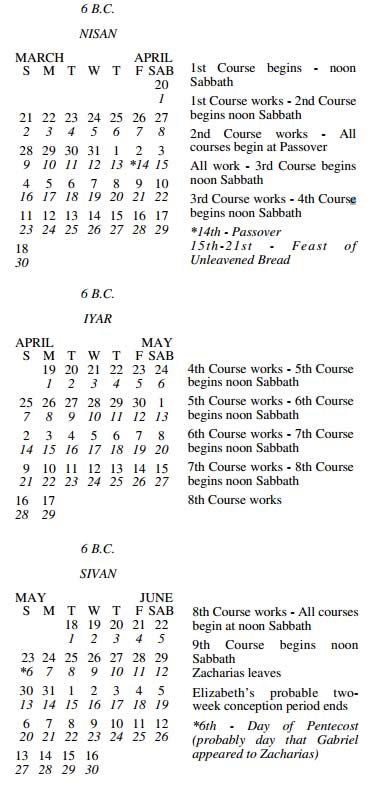
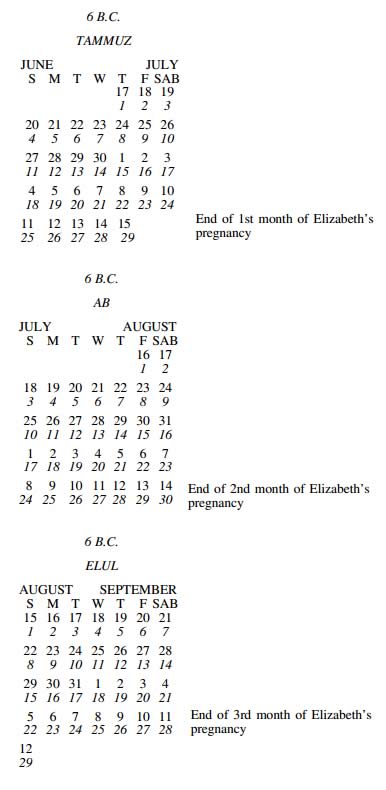
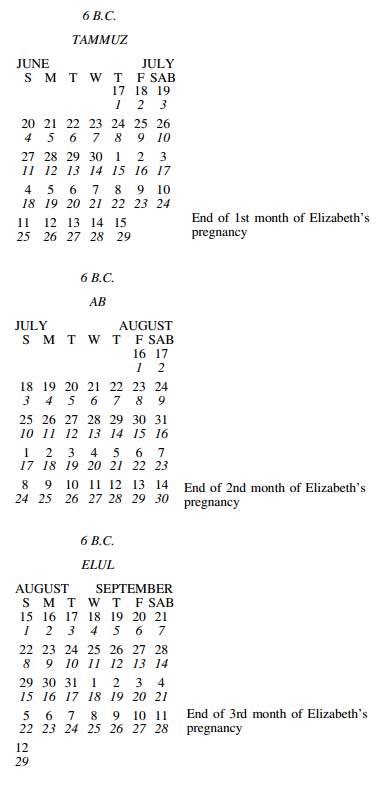
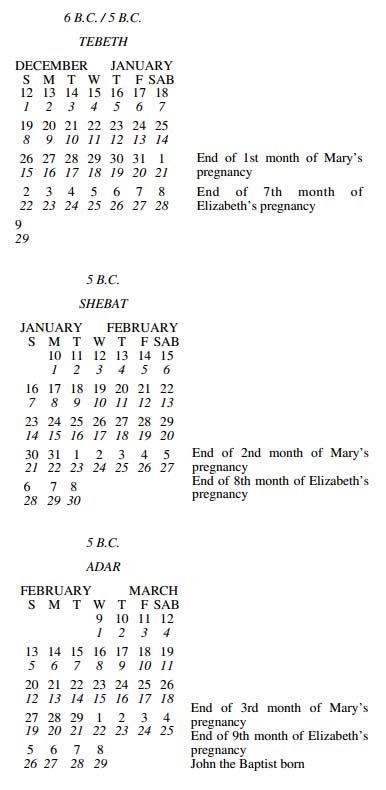
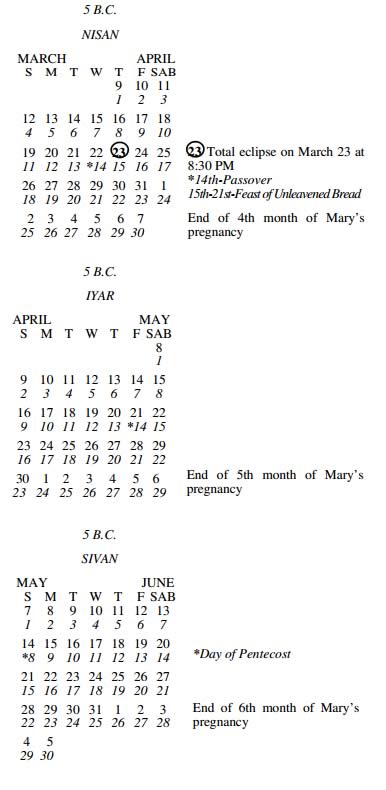
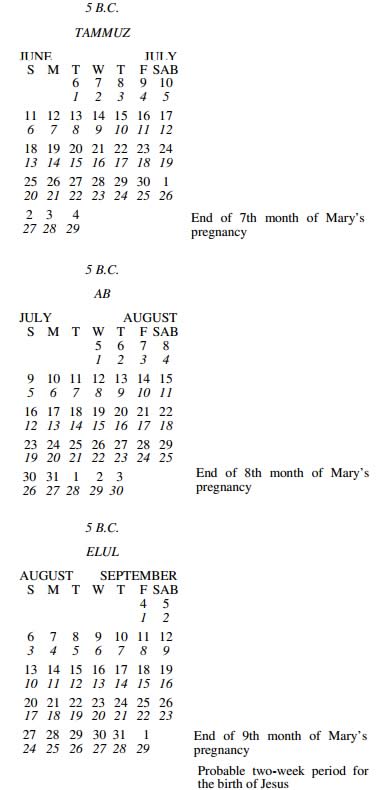
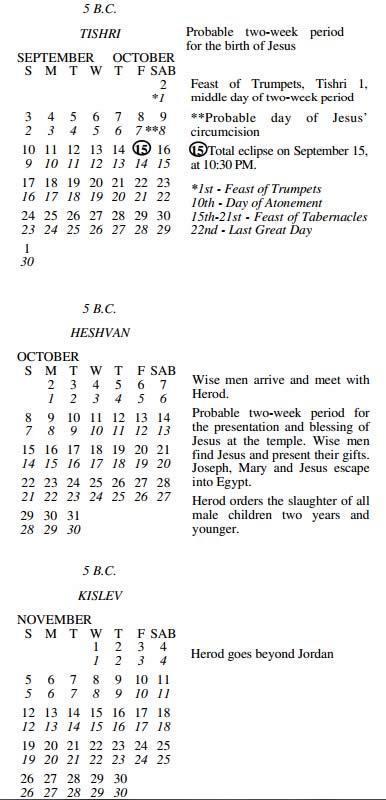

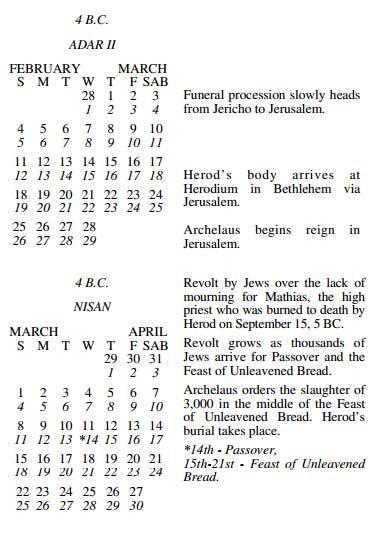
A Synchronized Chart of Historical and Scriptural Records That Establish the Year of Christ’s Birth
Few Bible students realize that a vast amount of evidence is available with which to prove the year of Jesus’ birth. In keeping with the biblical principle that a matter should be established by the testimony of two or three witnesses (Deut. 17:6; Matt. 18:16; etc.), we find that there are indeed three witnesses—history, Scripture and astronomy—which corroborate the year of Christ’s birth. These three witnesses combined build a valid case, proving conclusively that Jesus was born in the fall of 5 BC.
The primary scriptural records are those provided by Matthew and Luke. The astronomical evidence includes the full lunar eclipse of September 15, 5 BC, used to pinpoint the time of Herod’s death. (See Appendix E, “When Was Jesus Christ Born?”, p. 1258.)
The primary historical references that enable us to determine when Christ was born are those of Roman historians and of the Jewish historian Josephus, who lived from about 37 AD to 100 AD. These secular records can be used to establish the reign of Herod the Great, who attempted to kill the infant Jesus. Josephus records the names of the consuls who ruled in Rome at the time that Herod began his reign. Lists of all the consuls who ruled during the years from 509 BC to 337 AD have been preserved by Roman historians, giving us an exact time frame for dating the reign of Herod, which is essential to identifying the year of Christ’s birth.
Josephus records that Herod received the kingdom in Rome in the 184th Olympiad (Antiquities, 14:14:5). Each Olympiad was four years in length, with the years being reckoned from July 1 through June 30. The 184th Olympiad was from July 1, 44 BC, to June 30, 40 BC. Josephus also records that Herod began his reign when Calvinus and Pollio were consuls of Rome. Calvinus and Pollio were consuls from January 1, 40 BC, to December 31, 40 BC. Since the 184th Olympiad ended on June 30, 40 BC, it is evident that the reign of Herod as king in Rome began sometime between January 1, 40 BC, and June 30, 40 BC.
According to Josephus, Herod reigned thirty-seven years from the time of his coronation in Rome (Antiquities of the Jews, 17:8:1; Wars of the Jews, 1:33:8). Consequently, the end of his reign occurred sometime between January 1, 4 BC, and June 30, 4 BC. Since Jesus was born during the final months of Herod’s reign, the historical facts limit the time of His birth to the period from June 30, 5 BC, to June 30, 4 BC. Because the Gospels place His birth during the fall festival season, the time is further limited to the year 5 BC.
The historical and scriptural records are presented in chart form on the following pages.
| Greek Olympiad | Year of Rome | Year BC - AD | Hasmonian Rule | Reign of Herod | ||
| Roman Count | Jewish Count | |||||
| 179 | 1 | 691 | 63* | 100 | ||
| 2 | 692 | 62 | 101 | |||
| 3 | 693 | 61 | 102 | |||
| 4 | 694 | 60 | 103 | |||
| 180 | 1 | 695 | 59 | 104 | ||
| 2 | 696 | 58 | 105 | |||
| 3 | 697 | 57 | 106 | |||
| 4 | 698 | 56 | 107 | |||
| 181 | 1 | 699 | 55 | 108 | ||
| 2 | 700 | 54 | 109 | |||
| 3 | 701 | 53 | 110 | |||
| 4 | 702 | 52 | 111 | |||
| 182 | 1 | 703 | 51 | 112 | ||
| 2 | 704 | 50 | 113 | |||
| 3 | 705 | 49 | 114 | |||
| 4 | 706 | 48 | 115 | |||
| 183 | 1 | 707 | 47 | 116 | ||
| 2 | 708 | 46 | 117 | |||
| 3 | 709 | 45 | 118 | |||
| 4 | 710 | 44 | 119 | |||
| 184 | 1 | 711 | 43 | 120 | ||
| 2 | 712 | 42 | 121 | |||
| 3 | 713 | 41 | 122 | |||
| 4 | 714 | 40* | 123 | 1 | ||
| 185 | 1 | 715 | 39 | 124 | 2 | |
| 2 | 716 | 38 | 125 | 3 | ||
| 3 | 717 | 37 | 126 | 4 | 1 | |
| 4 | 718 | 36 | 5 | 2 | ||
| 186 | 1 | 719 | 35 | 6 | 3 | |
| 2 | 720 | 34 | 7 | 4 | ||
| 3 | 721 | 33 | 8 | 5 | ||
| 4 | 722 | 32 | 9 | 6 | ||
* 63 BC Jerusalem captured by Roman general Pompey during 179th olympiad. Antonius and Cicero are Roman consuls (Josephus, Ant., 14:4:3).
• 40 BC Herod receives kingdom in Rome during 184th olympiad. Calvinus and Pollio are Roman consuls (Josephus, Ant., 14:14:5).
† 37 BC Hasmoneans’ 126-year rule of Jerusalem ends during 185th olympiad. Herod receives kingdom in Jerusalem. Agrippa and Gallus are Roman consuls (Josephus, Ant., 14:16:4).
| Greek Olympiad | Year of Rome | Year BC - AD | Life of Christ | Reign of Augustus | Reign of Herod | Temple Rebuilt | ||
| Roman Count | Jewish Count | |||||||
| 187 | 1 | 723 | 31* | 1 | 10 | 7 | ||
| 2 | 724 | 30 | 2 | 11 | 8 | |||
| 3 | 725 | 29 | 3 | 12 | 9 | |||
| 4 | 726 | 28 | 4 | 13 | 10 | |||
| 188 | 1 | 727 | 27 | 5 | 14 | 11 | ||
| 2 | 728 | 26 | 6 | 15 | 12 | |||
| 3 | 729 | 25* | 7 | 16 | 13 | |||
| 4 | 730 | 24 | 8 | 17 | 14 | |||
| 189 | 1 | 731 | 23 | 9 | 18 | 15 | ||
| 2 | 732 | 22 | 10 | 19 | 16 | |||
| 3 | 733 | 21† | 11 | 20 | 17 | |||
| 4 | 734 | 20§ | 12 | 21 | 18 | 1 | ||
| 190 | 1 | 735 | 19 | 13 | 22 | 19 | 2 | |
| 2 | 736 | 18 | 14 | 23 | 20 | 3 | ||
| 3 | 737 | 17 | 15 | 24 | 21 | 4 | ||
| 4 | 738 | 16 | 16 | 25 | 22 | 5 | ||
| 191 | 1 | 739 | 15 | 17 | 26 | 23 | 6 | |
| 2 | 740 | 14 | 18 | 27 | 24 | 7 | ||
| 3 | 741 | 13 | 19 | 28 | 25 | 8 | ||
| 4 | 742 | 12 | 20 | 29 | 26 | 9 | ||
| 192 | 1 | 743 | 11 | 21 | 30 | 27 | 10 | |
| 2 | 744 | 10 | 22 | 31 | 28 | 11 | ||
| 3 | 745 | 9 | 23 | 32 | 29 | 12 | ||
| 4 | 746 | 8 | 24 | 33 | 30 | 13 | ||
| 193 | 1 | 747 | 7 | 25 | 34 | 31 | 14 | |
| 2 | 748 | 6 | 26 | 35 | 32 | 15 | ||
| 3 | 749 | 5 | 0 | 27 | 36 | 33 | 16 | |
| 4 | 750 | 4Ω | 1 | 28 | 37 | 34 | 17 | |
* 31 BCBattle of Actium, seventh year of Herod’s reign, 187th olympiad (Josephus, Ant., 15:5:1; 15:5:2).
• 25 BC Two-year famine begins in Herod’s thirteenth year (Josephus, Ant., 15:9:1).
† 21 BCAugustus visits Syria during seventeenth year of Herod’s reign; Apuleius and Silvius are Roman consuls (Dio’s Roman History, LIV:7:4-6; Josephus, Ant., 15:10:3).
§ 20 BC Construction of Herod’s temple begins in Herod’s eighteenth year (Josephus, Ant., 15:11:1).
5 BC Jesus born during fall festival season—most likely on the Feast of Trumpets.
Ω 4 BC Herod dies in thirty-seventh year of having received kingdom in Rome and thirty-fourth year of having received kingdom in Jerusalem (Josephus, Ant., 17:8:1; Wars, 1:33:8).
| Greek Olympiad | Year of Rome | Year BC - AD | Life of Christ | Reign of Augustus | Reign of Tiberius | Pilate Governs Judea | Temple Rebuilt | |
| 194 | 1 | 751 | 3 | 2 | 29 | 18 | ||
| 2 | 752 | 2 | 3 | 30 | 19 | |||
| 3 | 753 | 1 BC | 4 | 31 | 20 | |||
| There is no year zero | There is no year zero | There is no year zero | There is no year zero | |||||
| 4 | 754 | 1 AD | 5 | 32 | 21 | |||
| 195 | 1 | 755 | 2 | 6 | 33 | 22 | ||
| 2 | 756 | 3 | 7 | 34 | 23 | |||
| 3 | 757 | 4 | 8 | 35 | 24 | |||
| 4 | 758 | 5 | 9 | 36 | 25 | |||
| 196 | 1 | 759 | 6 | 10 | 37 | 26 | ||
| 2 | 760 | 7 | 11 | 38 | 27 | |||
| 3 | 761 | 8 | 12 | 39 | 28 | |||
| 4 | 762 | 9 | 13 | 40 | 29 | |||
| 197 | 1 | 763 | 10 | 14 | 41 | 30 | ||
| 2 | 764 | 11 | 15 | 42 | 31 | |||
| 3 | 765 | 12 | 16 | 43 | 1 | 32 | ||
| 4 | 766 | 13 | 17 | 44 | 2 | 33 | ||
| 198 | 1 | 767 | 14 | 18 | 45 | 3 | 34 | |
| 2 | 768 | 15 | 19 | 4 | 35 | |||
| 3 | 769 | 16 | 20 | 5 | 36 | |||
| 4 | 770 | 17 | 21 | 6 | 37 | |||
| 199 | 1 | 771 | 18 | 22 | 7 | 38 | ||
| 2 | 772 | 19 | 23 | 8 | 39 | |||
| 3 | 773 | 20 | 24 | 9 | 40 | |||
| 4 | 774 | 21 | 25 | 10 | 41 | |||
| 200 | 1 | 775 | 22 | 26 | 11 | 42 | ||
| 2 | 776 | 23 | 27 | 12 | 43 | |||
| 3 | 777 | 24 | 28 | 13 | 44 | |||
| 4 | 778 | 25 | 29 | 14 | 45 | |||
| 201 | 1 | 779 | 26* | 30 | 15 | 1 | 46 | |
| 2 | 780 | 27 | 31 | 16 | 2 | |||
| 3 | 781 | 28 | 32 | 17 | 3 | |||
| 4 | 782 | 29 | 33 | 18 | 4 | |||
| 202 | 1 | 783 | 30 | 33½ | 19 | 5 | ||
| 2 | 784 | 31 | 20 | 6 | ||||
| 3 | 785 | 32 | 21 | 7 | ||||
| 4 | 786 | 32 | 22 | 8 | ||||
* 26 AD Pontius Pilate assumes governance of Judea (Luke 3:1). Jesus begins ministry at about age thirty (Lk. 3:23). Herod’s temple 46 years in building (John 2:20).
30 AD Jesus crucified, Wednesday, April 5, 30 AD – The Passover Day, Nisan 14.
| Greek Olympiad | Year of Rome | Year AD | Reign of Tiberius | Pilate Governs Judea | |
| 203 | 1 | 787 | 34 | 23 | 9 |
| 2 | 788 | 35 | 24 | 10 | |
| 3 | 789 | 36 | 25 | ||
| 4 | 790 | 37 | 26 | ||
| 204 | 1 | 791 | 38 | ||
| 2 | 792 | 39 | |||
| 3 | 793 | 40 | |||
| 4 | 794 | 41 | |||
| 205 | 1 | 795 | 42 | ||
| 2 | 796 | 43 | |||
| 3 | 797 | 44 | |||
| 4 | 798 | 45 | |||
| 206 | 1 | 799 | 46 | ||
| 2 | 800 | 47 | |||
| 3 | 801 | 48 | |||
| 4 | 802 | 49 | |||
| 207 | 1 | 803 | 50 | ||
| 2 | 804 | 51 | |||
| 3 | 805 | 52 | |||
| 4 | 806 | 53 | |||
| 208 | 1 | 807 | 54 | ||
| 2 | 808 | 55 | |||
| 3 | 809 | 56 | |||
| 4 | 810 | 57 | |||
| 209 | 1 | 811 | 58 | ||
| 2 | 812 | 59 | |||
| 3 | 813 | 60 | |||
| 4 | 814 | 61 | |||
| 210 | 1 | 815 | 62 | ||
| 2 | 816 | 63 | |||
| 3 | 817 | 64 | |||
| 4 | 818 | 65 | |||
| 211 | 1 | 819 | 66• | ||
| 2 | 820 | 67 | |||
| 3 | 821 | 68 | |||
| 4 | 822 | 69 | |||
| 212 | 1 | 823 | 70† | ||
* 46 AD The apostle Paul begins his missionary journeys.
• 66 AD Jewish wars begin.
† 70 AD Destruction of Temple occurs.

